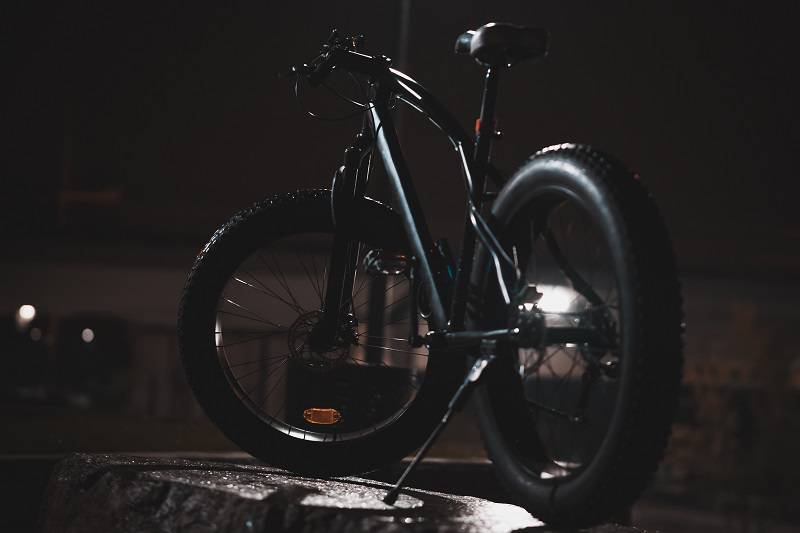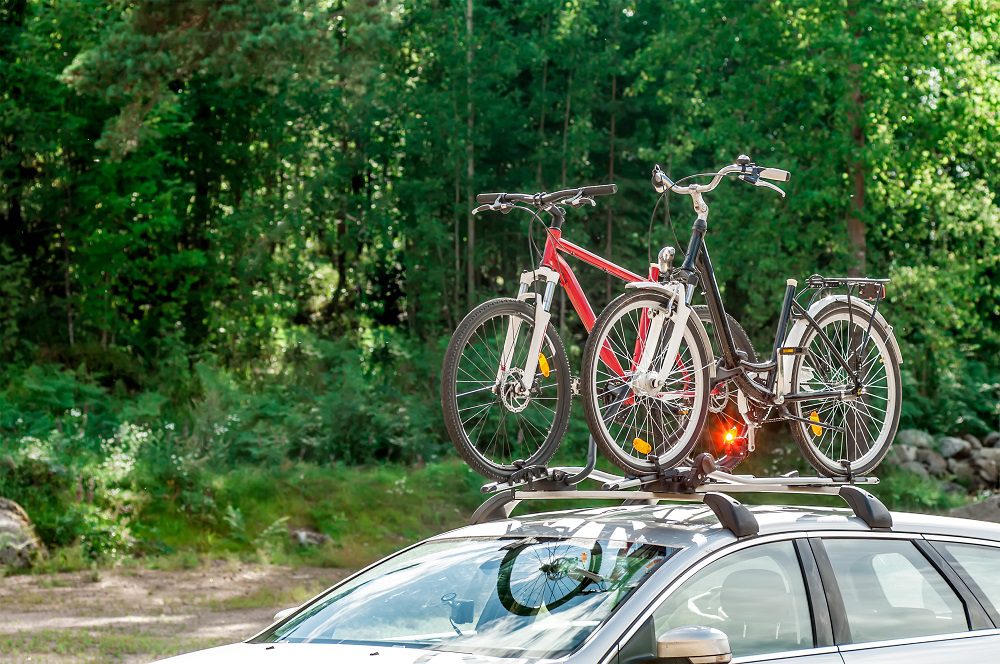
For SUV owners who need their hitch free for towing, want unobstructed access to the rear cargo area, or plan to carry other gear like kayaks or cargo boxes simultaneously, a roof bike rack is an excellent solution. While they require a bit more effort in loading, modern roof racks offer secure, stable, and often very aerodynamic ways to transport your bikes.
But which roof rack is right for your SUV and your specific bikes in 2025? This comprehensive guide dives into the different types of roof-mounted carriers, crucial features to consider for SUV compatibility, safe loading practices, and highlights top-performing models that combine security, ease of use, and versatility.
Why Choose a Roof Bike Rack for Your SUV? (And Key Considerations)
Roof racks offer distinct advantages:
- Unhindered Rear Access: Your SUV’s tailgate or hatch remains fully accessible at all times.
- Hitch Availability: Keeps your hitch receiver free for trailers or other hitch-mounted accessories.
- Versatile Gear Hauling: Can often be used alongside other roof-mounted carriers like cargo boxes or kayak mounts.
- Secure Hold: Quality roof racks provide a very stable and secure platform for your bikes.
However, for SUV owners, there are specific considerations:
- Lifting Height: This is the biggest challenge. Hoisting a bike, especially a heavier one, onto the roof of a tall SUV requires strength and care.
- Overall Vehicle Clearance: Your SUV’s height will significantly increase, demanding caution with parking garages, drive-thrus, and low-hanging branches.
- Crossbar System Required: You must have a compatible roof rack system (crossbars) installed on your SUV. These can be factory-installed or aftermarket (from brands like Thule or Yakima).
- Wind Noise & Fuel Economy: Roof-mounted gear can increase wind resistance and noise, potentially affecting fuel efficiency.
Types of Roof Bike Racks Explained
There are three main styles of roof bike racks:
Fork-Mount Racks:
-
- How they work: You remove the bike’s front wheel, and the fork dropouts are clamped securely to the rack. The rear wheel is strapped to a tray.
- Examples: Kuat Trio, RockyMounts JetLine / TieRod.
- Pros: Very secure and stable hold, generally the most aerodynamic and lowest profile (reducing wind noise and height), lighter rack weight.
- Cons: Inconvenience of removing and stowing the front wheel. Critical to ensure compatibility with your bike’s fork axle standard (e.g., quick-release, various thru-axle sizes – adapters are often needed or included).
Upright Wheel-Mount Racks (No Frame Contact):
-
-
- How they work: These racks secure the bike with its wheels on, typically by clamping the front wheel with an arm or hoop system, while the rear wheel is strapped down. There’s no contact with the bike frame.
- Examples: Yakima HighRoad, Thule UpRide, RockyMounts Tomahawk / BrassKnuckles.
- Pros: No frame contact (ideal for carbon frames or bikes with sensitive paint finishes), quick and easy to load as the front wheel stays on, often very versatile for different bike shapes and sizes.
- Cons: Bike sits higher, potentially increasing wind resistance and clearance issues. Can be bulkier than fork-mount racks.
-
Upright Frame-Mount Racks:
-
-
- How they work: These racks also keep both wheels on the bike. An arm from the rack clamps directly onto the bike’s downtube, while both wheels are strapped to the tray.
- Examples: Thule ProRide XT.
- Pros: Secure hold, often versatile for various frame shapes, good for bikes with fenders where wheel-only clamps might interfere.
- Cons: Direct contact with the frame can be a concern for delicate carbon frames if over-tightened or if the clamp design isn’t forgiving (though modern designs often include torque limiters or soft claw pads).
-
Top Roof Bike Racks for SUVs in 2025: Our Curated Picks
Here are some leading roof bike racks well-suited for SUV owners, balancing security, ease of use, and versatility:
| Feature | Yakima HighRoad | Thule UpRide | Thule ProRide XT | RockyMounts Tomahawk | Kuat Trio | RockyMounts JetLine |
|---|---|---|---|---|---|---|
| Mount Type | Wheel (No Frame) | Wheel (No Frame) | Frame | Wheel (No Frame) | Fork | Fork |
| Max Bike Wt. | ~45 lbs | 44 lbs (20kg) | 44 lbs (20kg) | 40 lbs (35 factory) | 45 lbs | 35 lbs |
| Max Tire Width | Up to 4" | Up to 3" (5" w/ kit) | Fits Most | Up to 5" | Standard (Fat adapt.) | Up to 2.7" |
| Frame Contact? | No | No | Yes | No | No | No |
| Tool-Free Install? | Yes | Yes (Often) | Yes (Often) | Yes (Often) | Yes (Often) | No (Hex Wrench) |
| Integrated Locks? | Cable (Core extra) | Sold Separately | Yes (Often) | Sold Separately | Sold Separately | Sold Separately |
| Pros | Easy Install, Secure | Carbon Safe, Versatile | Quick Secure, Fenders OK | Fat Bike Capable, Versatile | Axle Versatility, Secure | Great Value, Durable |
| Cons | SUV Lift Height | Locks Extra, SUV Lift | Frame Contact | Locks Extra, SUV Lift | Wheel Off, Locks Extra | Wheel Off, Not Tool-Free |
1.Yakima HighRoad (Wheel-Mount)

- Key Specs: Fits 26″-29″ wheels, tires 23mm to 4″. Max bike weight ~45 lbs. Universal crossbar compatibility.
- Standout Features: Tool-free installation, secures bike by wheels (no frame contact) with an adjustable hoop for the front tire and a rear wheel strap. TorqueRight™ tightening knob ensures secure clamping. Integrated cable lock (lock core sold separately).
- Pros: Very easy to install/remove, excellent bike security, no frame contact is ideal for carbon bikes.
- Cons: Lifting bike high is a factor on SUVs. Not compatible with full front fenders.
- Best For: SUV owners wanting a quick-to-install, frame-safe rack for various bikes on lower-roofed SUVs or those comfortable with the lift.
- Learn More: Yakima Official Site
2. Thule UpRide (Wheel-Mount)
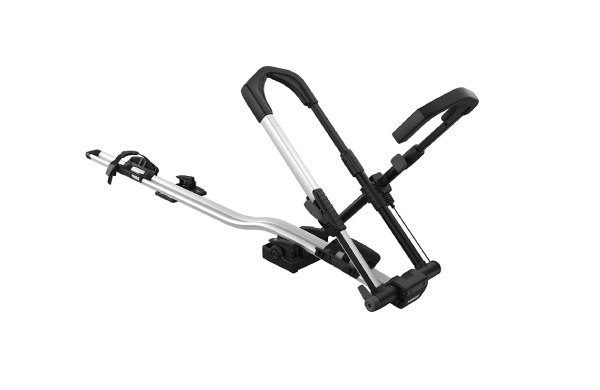
- Key Specs: Fits 20″-29″ wheels, tires up to 3″ (5″ with fat bike adapter, sold separately). Max bike weight 44 lbs (20 kg).
- Standout Features: Secures bike via front wheel hook and rear wheel strap (no frame contact). Suitable for carbon frames and bikes with non-traditional designs or rear suspension. Easy to switch carrier side.
- Pros: Excellent frame protection, versatile for many bike designs, secure hold.
- Cons: Locks for bike-to-rack and rack-to-vehicle often sold separately. Higher lift than fork mounts.
- Best For: Protecting valuable frames (especially carbon), accommodating unique bike designs.
- Learn More: Thule Official Site or on Amazon.
3. Thule ProRide XT (Frame-Mount)
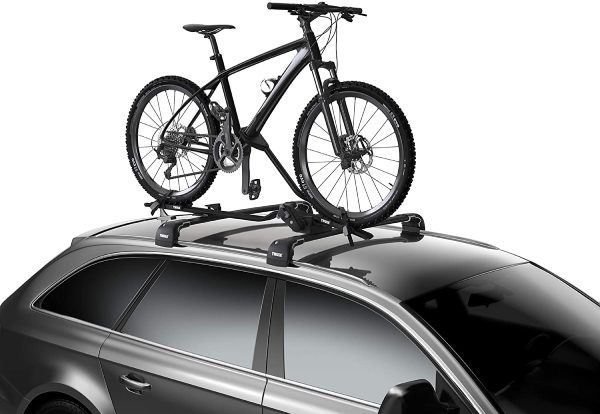
- Key Specs: Max bike weight 44 lbs (20 kg). Fits most factory and aftermarket crossbars.
- Standout Features: Uniquely designed frame holder and wheel tray automatically position the bike. Torque limiter dial ensures secure clamping force on the frame without over-tightening. Soft claw pads adapt to frame tubes.
- Pros: Quick and easy bike securing, good for bikes with fenders where wheel-only clamps might not work, stable wheel holders.
- Cons: Frame contact, though designed to minimize risk.
- Best For: Users needing to carry bikes with fenders or wanting a very quick frame-clamping system from a reputable brand.
- Learn More: Thule Official Site or see what users say on Bikeradar.
4. RockyMounts Tomahawk (Wheel-Mount)
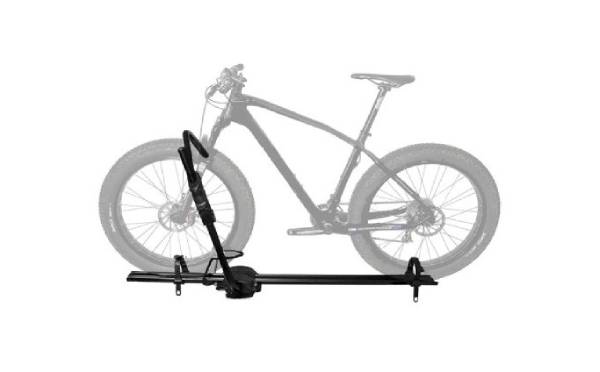
- Key Specs: Fits tires up to 5″ wide (fat bike compatible), wheels 20″-29″. Max bike weight 40 lbs (35 lbs on factory bars).
- Standout Features: Highly versatile for almost any bike style, including fat bikes. Secures bike by front wheel (no frame contact). Low profile when not in use.
- Pros: Excellent versatility, easy to load/unload, good for users with diverse bike collections.
- Cons: Lock cores often sold separately.
- Best For: SUV owners with a variety of bikes, including fat bikes, who want a single, versatile wheel-mount solution.
- Learn More: RockyMounts Official Site
5. Kuat Trio (Fork-Mount)

- Key Specs: Fits 9mm QR, 15x100mm, and 15x110mm Boost thru-axles out of the box. Max bike weight 45 lbs. Fat bike adapters available.
- Standout Features: High-quality construction, excellent durability, and ease of use for a fork mount. Adapters make it very versatile for different axle standards. Sleek look.
- Pros: Eliminates need for many axle adapters for common standards, very secure hold, lower bike profile on roof.
- Cons: Requires front wheel removal. Adapters for some less common or fat bike fork standards are extra.
- Best For: Users with thru-axle bikes (especially multiple bikes with different standards) who prefer the security and aerodynamics of a fork mount.
- Learn More: Kuat Racks Official Site
6. RockyMounts JetLine (Fork-Mount)
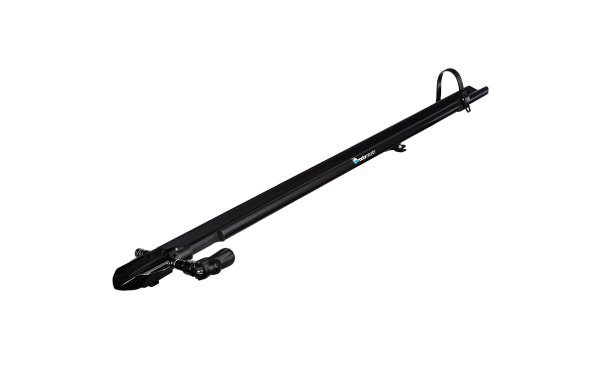
- Key Specs: Fits tires up to 2.7″ wide, wheels 20″-29″. Max bike weight 35 lbs.
- Standout Features: Often praised as a “Best Buy” for its balance of quality construction and affordable price. Simple, easy-to-use fork mount design. Aerodynamic and low profile.
- Pros: Excellent value, durable metal construction, secure attachment. Adapters available for thru-axles.
- Cons: Requires front wheel removal. Installation/removal from crossbars requires a hex wrench (not tool-free).
- Best For: Budget-conscious SUV owners seeking a reliable, secure, and low-profile fork-mount rack, primarily for road or standard mountain bikes.
Essential Features: Choosing Your 2025 SUV Roof Bike Rack
Consider these factors carefully:
Crossbar Compatibility: This is paramount. The roof bike rack must be compatible with your SUV’s specific roof crossbar system (e.g., factory-installed bars, or aftermarket aero, square, or round bars from brands like Thule, Yakima, or Rhino-Rack). Check the rack’s specifications for clamp style and fit. Reputable sites like REI offer guides on car racks.
Bike Compatibility:
-
- Wheel Size & Tire Width: Ensure the rack accommodates your bike’s wheel diameter (e.g., 26″, 27.5″, 29″) and tire width (road, mountain, plus-size). Most standard roof racks handle tires up to ~3 inches; some (like Yakima HighRoad or RockyMounts Tomahawk) can fit up to 4-5″ fat bike tires with specific kits or designs.
- Axle Standards (for fork-mount racks): If choosing a fork-mount, verify it works with your bike’s front axle (e.g., 9mm QR, 12×100, 15×100, 15×110 Boost thru-axles). Many, like the Kuat Trio, come with multiple adapters.
- Frame Design (for frame-mount racks): Check for compatibility with your bike’s frame shape and material, especially for carbon frames.
Weight Capacity (Per Bike): Roof racks generally have a lower per-bike weight capacity (often 35-45 lbs, max around 44 lbs for Thule UpRide/ProRide XT) than hitch racks. They are usually NOT suitable for heavy e-bikes. Always respect the stated limit.
Ease of Installation & Use: How simple is it to install the rack onto your crossbars? Is it tool-free? How intuitive is securing the bike, keeping in mind you’ll be lifting it onto your SUV’s roof?
Security: Look for integrated locks to secure the bike to the rack and the rack to the vehicle’s crossbars. Many brands offer SKS (Same Key System) options for convenience.
Aerodynamics and Build Quality: A sleek, low-profile design can help minimize wind noise and fuel consumption. High-quality materials (aluminum, sturdy plastics) ensure durability.
Clearance: Account for the added height with the bike loaded. Measure your SUV’s total height to avoid costly accidents with garages or low overhangs.
Loading Bikes onto an SUV Roof Rack Safely
- Use a Step Stool: For taller SUVs, a small, sturdy step stool can make a huge difference.
- Lift Smart: Lift with your legs, keeping your back straight. Position the bike close to your body.
- Secure Immediately: Once the bike is on the rack, engage at least one securing mechanism immediately before letting go.
- Get Help: If the bike is heavy or you’re struggling, ask for assistance.
- Double-Check Everything: Before driving, ensure all clamps, straps, and levers are fully engaged and tightened. Test by gently trying to move the bike.
Maintaining Your Roof Rack System
- Regular Cleaning: Wash the rack occasionally to remove dirt, grime, and road salt.
- Inspect Hardware: Periodically check all bolts, clamps, and straps for tightness and wear. Replace any worn components.
- Lubricate Moving Parts: Lightly lubricate pivot points or locking mechanisms as per the manufacturer’s recommendations.
- Check Crossbars: Ensure your SUV’s roof crossbars are also securely attached and in good condition.
Conclusion: Reaching New Heights with Your Bikes
For SUV owners needing their hitch for other purposes or desiring clear rear access, a roof bike rack is a solid and reliable choice in 2025. While lifting bikes onto an SUV roof requires consideration, modern racks from brands like Yakima, Thule, RockyMounts, and Kuat offer impressive security, ease of use, and compatibility with a wide range of bikes.
Consider the types of bikes you’ll carry, your comfort with lifting, your SUV’s crossbar system, and features like frame protection or axle compatibility. Whether you opt for a wheel-mount system like the versatile Yakima HighRoad or a secure fork-mount like the adaptable Kuat Trio, investing in a quality roof rack will open up new destinations for your cycling adventures.

